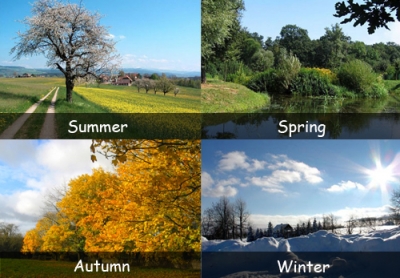
Earth takes a year to travel, or orbit, around the Sun. At the same, it spins on its axis, an imaginary line between the Poles. This means the amount of sunlight falling on any area of Earth varies during the year, changing weather and creating seasons – spring, summer, autumn, and winter.
Spring:
Spring is a time of change between summer and winter. Days gradually get brighter, warmer, and wetter. Animals that have been hidden away in a deep sleep called hibernation wake up and come out from dens. Many birds and animals return from their winter homes and start to breed. In the northern hemisphere, Earth’s upper half, spring begins in March. In the southern hemisphere, Earth’s lower half, spring begins in September.
Summer:
Summer is the hottest season. The days get longer and the nights become shorter. Plants grow well in the warm sunlight. There are lots of green leaves on the trees. People spend time outside, enjoying the long, sunny days. In the northern hemisphere, Earth’s upper half, it is summer from June to September. In the southern hemisphere, Earth lower half, it is summer from December to March.
Winter:
Winter is the coldest season. Days get shorter and nights get longer. Some animals grow thick coats to keep them warm in winter. Others just fall asleep, or hibernate. People need to heat their homes and wear thicker clothes to keep warm. The freezing winds often bring snow and ice. Winter lasts from December to March in the northern hemisphere, Earth’s upper half, and from June to September in the southern hemisphere, Earth’s lower half.
Autumn:
Autumn is when summer gradually changes into winter. In some places, rainfall increases. In areas with icy winters, some trees, such as oak, sycamore, and birch, prepare to lose their leaves. These trees are called deciduous trees. They stop producing chlorophyll, which is a chemical that helps plants make food from sunlight and also gives leaves their green color. As chlorophyll gradually disappears from the leaves, they turn to shades of red, orange, yellow, and brown. Many plants make seeds that will become new plants in spring. Some animals grow thicker fur to get ready for the cold winter. Others gain weight to prepare for a deep sleep called hibernation to take them through winter. In the northern hemisphere, Earth’s upper hals, fall takes place from September to December, and in the southern hemisphere, Earth’s lower half it is from March to June.
Picture Credit : Google




